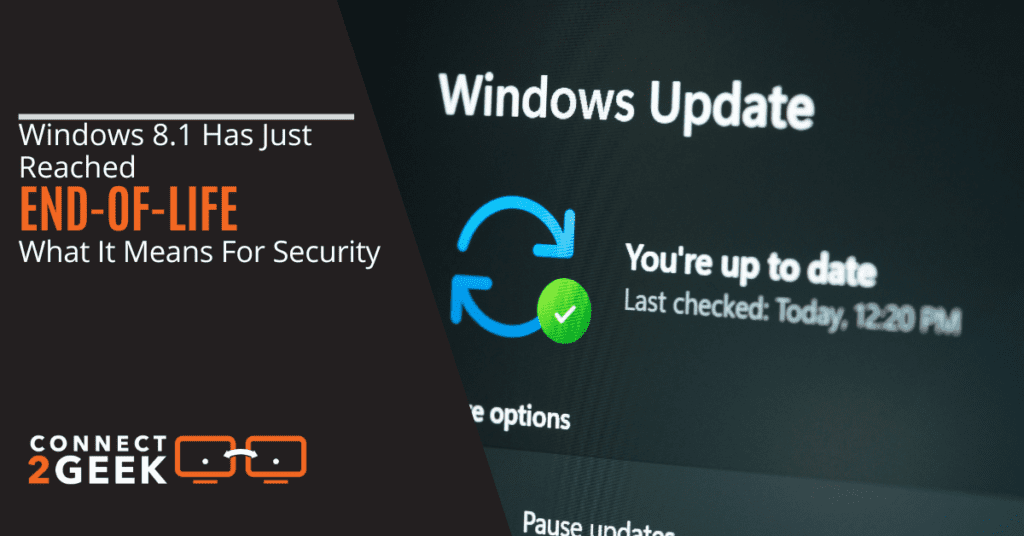
Are you still running Windows 8.1 on your computer? If so, it’s time to take notice. Microsoft’s popular operating system, Windows 8.1, released in 2013, officially reached end-of-life (EOL) status on January 10, 2023, meaning the tech giant will no longer provide technical support or security updates.
With an estimated 2.6% of all personal computers worldwide still running Windows 8.1, this news should be a cause for concern for users worldwide because the lack of security updates can leave a computer running Windows 8.1 vulnerable to malware and hackers.
End-of-Life (EOL) is a term used to describe the point at which its manufacturer no longer supports a software product. Once a product reaches EOL, the manufacturer will no longer provide technical support, bug fixes, or security updates. This can be a significant problem for users, as their computer is no longer protected against new vulnerabilities discovered.
This article will explore the implications of Windows 8.1 EOL, the potential security risk, and what users can do to protect their computers.
Potential Security Risks Of Windows 8.1 End-Of-Life.
The following are some of the things that can happen to PC users who still run Windows 8.1 after its end of life.
Exploitation of New Vulnerabilities By Hackers
One of the main concerns with Windows 8.1 reaching EOL is the lack of security updates. As new vulnerabilities are discovered, hackers will easily exploit them to access a user’s computer. This can lead to various issues, including the theft of personal information, the installation of malware, or even the complete takeover of the computer.
Easy Installation of Malware and Theft of Personal Information
Installation of malware and theft of personal information is one of the potential security risks associated with Windows 8.1 reaching end-of-life (EOL) status. This is because the lack of security updates makes the computer more vulnerable to malware and hackers, who can use known vulnerabilities to gain unauthorized access to the user’s computer.
Easy Access for Hackers
Many users may not even know that their computer is running an EOL version of Windows. Many users may not even know that Windows 8.1 has reached EOL, so they may not take any steps to protect their computers. This can make it even easier for hackers to gain access to a user’s computer, as they may not be taking any precautions to protect their computer.
Lack of Protection Against New Threats
With no new security updates, the computer running Windows 8.1 is not protected against new threats and malware that have emerged since the EOL date. Lack of protection means the computer is at a higher risk of getting infected with new types of malware that can evade traditional security solutions. This can make detecting and removing malware from an infected computer more complicated and potentially lead to more severe consequences.
Steps To Secure Your Computer
With the end of windows 8.1. your computers will still function, but technical support and security updates for the version will discontinue Users can help protect their computers from potential security risks associated with Windows 8.1 reaching end-of-life (EOL) status by taking these steps.
Upgrade To a Newer Version of Windows
The best way to protect your computer from potential security risks is to upgrade to a newer version of Windows. You can upgrade to Windows 10, which will be available until October 14, 2025, or upgrade to Windows 11. However, if you own an old PC that cannot install windows 11, we recommend you buy a new PC that uses Windows 11.
Use a Different OS
Another option is to use a different operating system (OS) altogether. While Windows is the most popular OS, other options are available, such as Linux or macOS. These OS’s are generally considered more secure than Windows, which may provide better protection against malware and hackers. By switching to a different OS, users can continue to receive security updates and support and reduce the risk of malware and hacking.
Be Cautious About Websites and Email
Another way to protect a computer from malware and hacking is to be careful about the types of websites a user visits and the emails they open. These are common ways for hackers to gain access to a user’s computer, so it’s essential to be cautious about clicking on links or downloading attachments from unknown sources.
Keep Software Up To Date
Updating software is essential, as updates often include security fixes. This means that by keeping software up to date, users can reduce the risk of malware and hacking by patching known vulnerabilities. It’s important to note that this applies to all software, not just the OS, and users should check for updates for all software installed on their computers.
Get an Upgrade Today
The lack of security updates can leave your computer vulnerable to malware and hackers. Connect2Geek will help you upgrade to a newer version and guide you on securing your computer.
To schedule a free consultation with us today, call us at 208-468-4323 or reach us online
